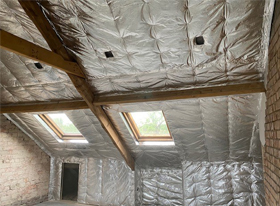Create a More Energy Efficient Home with Multifoil Loft Insulation
Create a More Energy Efficient Home with Multifoil Loft Insulation
To enhance the energy efficiency of a house, it is crucial to have enough insulation in the loft. This is important because of the loft. This is important because the loft is where most of the heat can escape, and it plays a crucial role in maintaining a comfortable and cost-efficient living space. A growing number of homeowners in the UK are recognising the importance of investing in high-quality loft insulation to improve the thermal performance of their property and reduce their energy costs. This article will explore methods to create a more energy-efficient home with multifoil loft insulation.

The Importance of Energy Efficiency
Recently, energy efficiency has emerged as a key concern for homeowners, driven by the need for environmental preservation and economic advantages. Due to the rising cost of energy, there is a growing recognition of the significance of limiting heat loss and minimising energy consumption. Proper insulation of the loft plays a crucial role in preventing heat from escaping, maintaining a consistent and comfortable indoor temperature, and reducing the strain on heating systems.
What is Multifoil Insulation?
Multifoil insulation is a type of insulation material that is used to provide thermal insulation within a building. It is made up of multiple layers of reflective foil, typically alongside other other insulating materials. The purpose of this insulation is to prevent heat transfer and heat radiation, by reflecting heat into the building.
Multifoil insulation is typically made from reflective foil, wadding, foam, or an air-filled bubble membrane. It is specifically designed to reflect radiant heat and prevent heat transfer. It consists of multiple layers of reflective material that work in tandem to reflect heat and hinder its transfer. This makes it an efficient method for maintaining warmth in buildings during winter and keeping them cool in summer. Due to its affordability and eco-friendliness, multifoil insulation is gaining popularity as a preferred choice for insulating homes and structures.
Insulate Your Loft with Multifoil Insulation
Adhere to Existing Building Regulation
If your goal is to meet the latest building regulations, the only multifoil insulation product that has been fully accredited by BBA and BDA is YBS SuperQuilt. It is the highest-performing product compared to other multifoil insulation, due to its 19 layers of aluminium foil and wadding which is around 40mm thick and compresses down to 10mm. SuperQuilt can also be used to enhance your EPC rating, which is required for all rental properties and when selling a property.
The installation of SuperQuilt is straightforward thanks to how flexible the insulation is. It also will not deteriorate over time like traditional fibre loft insulation. Furthermore, SuperQuilt does not contain any loose or irritating fibres, removing the necessity for PPE while installing. When taped and sealed with ThermaSeal Foil Joining Tape SuperQuilt will create a Vapour Control Layer and protect your home from issues with mould and dampness.
Enhance Your Current Insulation
If you want to improve the insulation in your loft, we recommend using EcoQuilt Expert. We have created two DIY loft insulation kits that utilise EcoQuilt Expert. These include the Under Rafter Insulation Kit as well as the Loft Floor Insulation Kit. These Kits come with all the tools required for the installation process.
The EcoQuilt Expert is made from six layers of wadding and highly reflective foil. It’s 15mm thick but can be compressed down to just 6mm. EcoQuilt Expert is equivalent to 100mm of Fibre Glass in terms of thermal performance. It’s a perfect choice for DIY projects and can be effortlessly installed in even the smallest areas. When taped and sealed EcoQuilt Expert will also create a Vapour Control Layer.
Conclusion
Multifoil insulation is a top choice for those seeking to make their home more energy-efficient by insulating their lofts. Its unique combination of reflective and insulating properties, as well as its adaptability, moisture management capabilities, and long-lasting thermal performance, make it a desirable option for anyone aiming to enhance their living spaces and reduce their energy costs.

